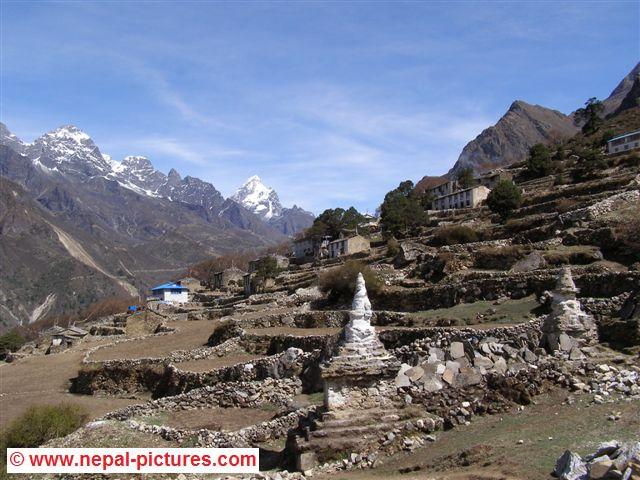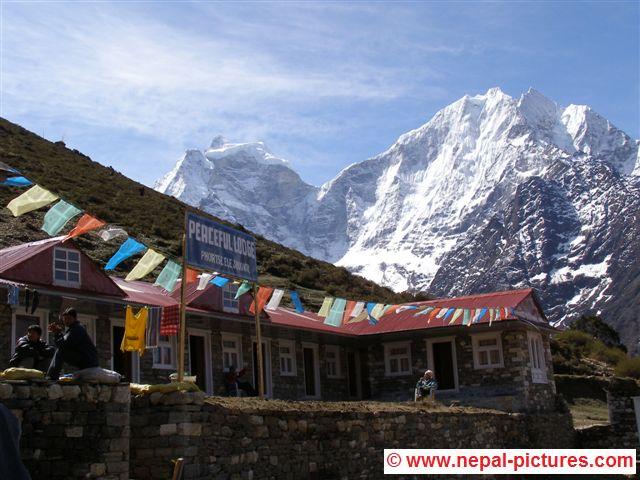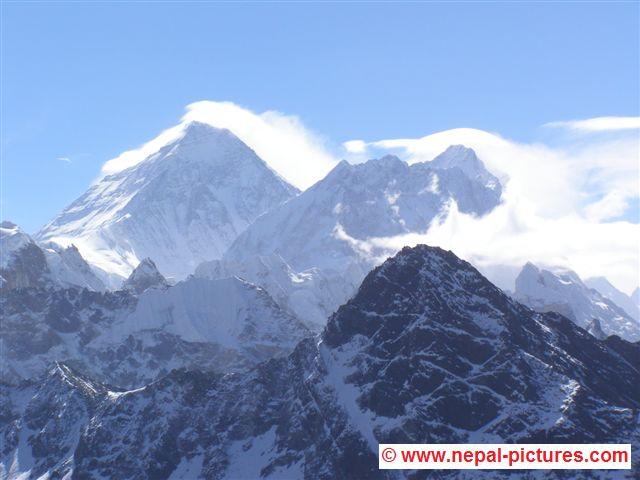Gokyo Trek: Gokyo Ri & Tengboche
Climbing Gokyo-Ri
The next morning the alarm is set at 3:30 am (no typo), because the ascent of the Gokyo-Ri (the peak above the village of Gokyo) is on the program. This climb takes about 2 to 3 hours and the sun rises around 5:30 am. Early in the morning you have the best chance of clear weather. However, it is still completely cloudy, so we postpone our departure for another hour. Then we jump over boulders over the river while it is still dark and then start the difficult steep climb from 4,750 meters to 5,350 meters. Because of the altitude you really do not move quickly. Unfortunately it is not very clear, but there beautiful views every are now and then. The sun and the clouds seem to play a game with each other, where the clouds were allowed to win this day.


When we reach the summit, we turn out to be the only one. We enjoy the peace and the beautiful views that always emerge in a different place between the clouds. The prayer flags covered with frost are almost stationary. After enjoying the spectacle for an hour, the clouds think it has been enough and the whole region is buried under a gray mass. So we start the descent as it starts to snow softly. This snow keeps falling and only gets heavier. It also gets quite cold and we spend most of the day inside the lodge, where the stove is fired all day with the help of Yak shit. In between cooking, the lodge’s kitchen maid walks to the river to get water, fetches new dried Yak shit or picks up freshly produced Yak shit from the garden with her bare hands and kneads it into beautiful plaques before returning to the kitchen to knead momo dough.
Only at the end of the afternoon the weather clears up a bit and we can take a walk in the fresh snow, giving the area a beautiful new look.
Again to Gokyo-Ri
Due to the enormous amount of rainfall, there is a reasonable chance that it will be a lot brighter the next day and Arno plans to climb the Gokyo Ri again before the trip to Phortse.
The next morning it is indeed very clear and so Arno starts the second climb, which is now a lot faster. The view is now breathtaking. There are only 2 people on top of the peak and it is very quiet. The silence is only broken every now and then by the creak of the glacier, an avalanche thundering in the distance and every now and then a stray bird. It is quite enjoyable, but not too long, as the long journey to Portse is on the program.


After this steep climb to Gokyo-Ri, we walk down in 1 day, where we needed 3 days on the way up. There are 2 routes to Portse, along the west side of the valley and along the east side. We have already taken the west side, but since there seems to be only one lodge on the east side and we cannot properly estimate how good our legs are, we choose to go back the same way, which by the way offer a completely new view at the landscape.
As is often the case, we also get company from a dog during this walk. They sometimes run with you for a few hours to days. At the next hamlet, however, there is another dog who wants to walk with us and it seems that there is going to be a fight about who can come with us. But after some probing, they seem to decide that the four of us are even more fun and they walk around us for hours running, playing and chasing. Now and then we have to be careful not to trip over them, because you might fall into a ravine. The latter seems to happen every now and then, strangely enough mainly with people who trek all by themselves. There are also many notes in the vicinity of missing persons and the relatives of a missing Englishman have completely set up a book system in which trekkers can indicate when they were where, so that relations of missing persons can have leads on where to look.
These days there is mainly a hard search for a German woman who has been missing for 2 months. Her body is found in the valley we pass this day. It is striking that all her valuables (including her shoes) are missing.
We arrive in Phortse at 6.30 pm. The last part we are guided by a teacher from the village, who invites us to come and take a look at the school the next day.
In the lodge we meet our Russian “friends” again. They have taken the shorter east route with their porters.
The next day we sleep in and pay a visit to the school in Phortse before going to hike. This one is sponsored by an Englishman and in itself looks reasonable for a rural school. What is very crooked, however, is that the school in Sherpa area has only Nepali teachers. The small children only speak Sherpa and the success rate in the first grades is shockingly low due to this language barrier.



From Phortse to Tengboche
After this visit we start the relatively short hike to Tengboche. Since we don’t feel like a long trip, we take the much shorter local route. This takes us via a steep route along a beautiful rock wall, where we also encounter musk deer, at the bottom of the river valley between Tengboche and Phortse. The route then goes up again via an even steeper muddy forest path to Tengboche. Especially the climb through Rhododendron forest is still difficult and occasionally becomes real hands and feet work, where we have to pull ourselves up on the trees every now and then.
At 1 p.m. we arrive in Tengboche where we have the time to relax and walk a bit. In Tengboche, where a bottle of cola costs 4 times as much as a double room, is the most famous monastery of the Khumdu region. This monastery is located on a beautiful more or less flattened hill at 3870 meters, completely surrounded by impressive Himalayan giants such as Ama Dablam, Mount Everest, Thamserku, Nuptse, Kantega and Lhotse.
In the afternoon it is cloudy again and later also very foggy, which gives the whole a mysterious atmosphere. From time to time beautiful peaks emerge from the fog and disappear again just as quickly. It is as if god operates the buttons of the light show and the fog machine and alternately illuminates another peak, then turns off the fog machine for 15 minutes and provides a beautiful panoramic mountain view before turning the fog machine on full power, making all the mountains. disappear permanently into the fog.
During dinner we have a chat with 2 Canadians and their guide. This guide tells us that locals and tourists donate quite a bit of money to the monastery and that partly because of this, the Lama Rimpoche can be flown by helicopter from Tengboche to Kathmandu when another visit is planned elsewhere. The Canadians look glum. They would have liked to know before making their generous donation. In the visitor center, lists are given of what can be achieved with donations. In any case, some of the costs mentioned seem to us to be quite high. It is reported that there are also at least 4 lodges and the local internet cafe (also rs 20 per minute) owned by the monastery.
We stay at a lodge run by family of Tenzing Norgay, Sir Edmund Hillary’s partner, on his successful first ascent of Mount Everest in 1953. The host proudly displays a book of interesting photos and letters.



The next morning we wake up to a view of Everest, Nuptse and Ama Dablam from our bed and honk from the monks announcing the morning ceremony. We hurry to the monastery, where the number of hikers far exceeds the number of monks. Not that there are so many trekkers (maybe 15), but because most monks are in Khumde and Khumjung for blessings (see part 1 of Gokyo report), there are not so many left in Tengboche itself. The morning prayers last about an hour and when we leave the monastery, we can fully enjoy the beautiful 360 degree mountain view again. The monks know where to sit.
After breakfast we really go on the way back to Lukla. First to Namche Bazar that we reach via a steep descent and then a long tedious climb. Not that this climb was that difficult, but on day 11 of the trek and on the way back we can not get much motivation for the climbing this time. While we slog up meter by meter, we are occasionally literally sprinted by sporty dressed people. It turns out that training is already underway for the approaching Everest Marathon on May 29. A trip in which sports enthusiasts (called simply crazy by many people) run from Everest Base Camp to Namche Bazar in about 4 to 5 hours. Small weak point is that this road is largely downhill, but still quite an impressive achievement.
From Namche back to Lukla
Our last stage from Namche Bazar to Lukla will follow on Wednesday May 17. We like the descent from Namche to Monju a lot better than the opposite route. Halfway we have a nice last view of Mount Everest. From Monju it is still quite a tough walk and only at 5.30 pm we arrive in Lukla where we choose a lodge right next to the airport and immediately reconfirm our flight for the next day.
Due to its awkward location between the mountains and sandwiched between ravine and mountain peak, Lukla airport is known for its many enormous delays, where people sometimes have to wait days up to a few weeks before they can fly out. The weather has been good the past few days and there are very few trekkers, so we shouldn’t expect too many problems. Still, the man from Gorkha Airlines has an unpleasant announcement for us. Gorkha turns out not to fly the next day, because the plane is needed on a different route. He will try to transfer us to another airline. That means that from the first flight from Gorkha we suddenly have to join another airline at the back of the queue. We will find out what that means the next day.
After dinner we think we will go for a walk through Lukla, when it turns out that the entire airport area is hermetically sealed from the outside world due to security regulations. We are completely surrounded by barbed wire and military. Then go to bed early.
The next day we arrive early so that together with our Gorkha friend we can try to arrange another flight as early as possible. Unfortunately the weather is not that good this morning, so between the clouds there are only a few planes coming in. Our friend tells us that usually there is no more flight after 12 o’clock because of the strong wind. Finally at 11 am we get our boarding passes for a flight from Yeti airlines, but the plane has yet to come in. This will take another hour and a half. Only after 13:00 flying / shaking (with an even smaller plane than on the way to Lukla) between clouds, rain showers and mountains towards Kathmandu. Some passengers hold on to the person next to them on the cozy 2-person sofas, while the co-pilot reads a newspaper quietly. We can also say that we have had more pleasant flights and are happy when the plane lands at Kathmandu airport.
This Thursday, May 18 is another memorable day in Nepal. And we’re not talking about the fact that as many as 42 climbers reach the top of Mount Everest on this day (one of the highest numbers ever in one day), but about the enormous political developments. On this day, the new government will make short work of the king’s power with, among other things, the following measures:
– the army will from now on fall under the government instead of the king and the government appoints the Army Chief
– the king has to pay taxes
– the king’s actions can henceforth be judged and punished by the judge
– the staff of the royal palace is considerably reduced
– the government is now called “Nepalese government” instead of “His majesty’s government”
– the army is now called “Nepalese Army” instead of “Royal Nepalese army”
– there will be elections regarding the role of the royal family
These and other measures immediately give rise to a new folk festival and the next day is declared a national holiday, on which many government institutions are immediately enabled to make name changes and remove references to the king.
In the meantime, it is worrying that quite a few Nepalese turn out to be quite confused. A few weeks after the major demonstrations, riots take place regularly in and outside Kathmandu. Causes are usually deaths or traffic accidents. Involved drivers, doctors or entire hospitals are besieged by an angry mob, after which police intervention can sometimes lead to hours of disturbances and traffic jams. Are these the same Nepalese who recently demonstrated for peace and democracy ???
We use the days after the trekking adventure to catch up on work, handle many emails, visit the Hamro Niwas children’s home and make trips to Pashupatinath and Swayambunath, among others.
Another two weeks and then we will fly back to Amsterdam.

